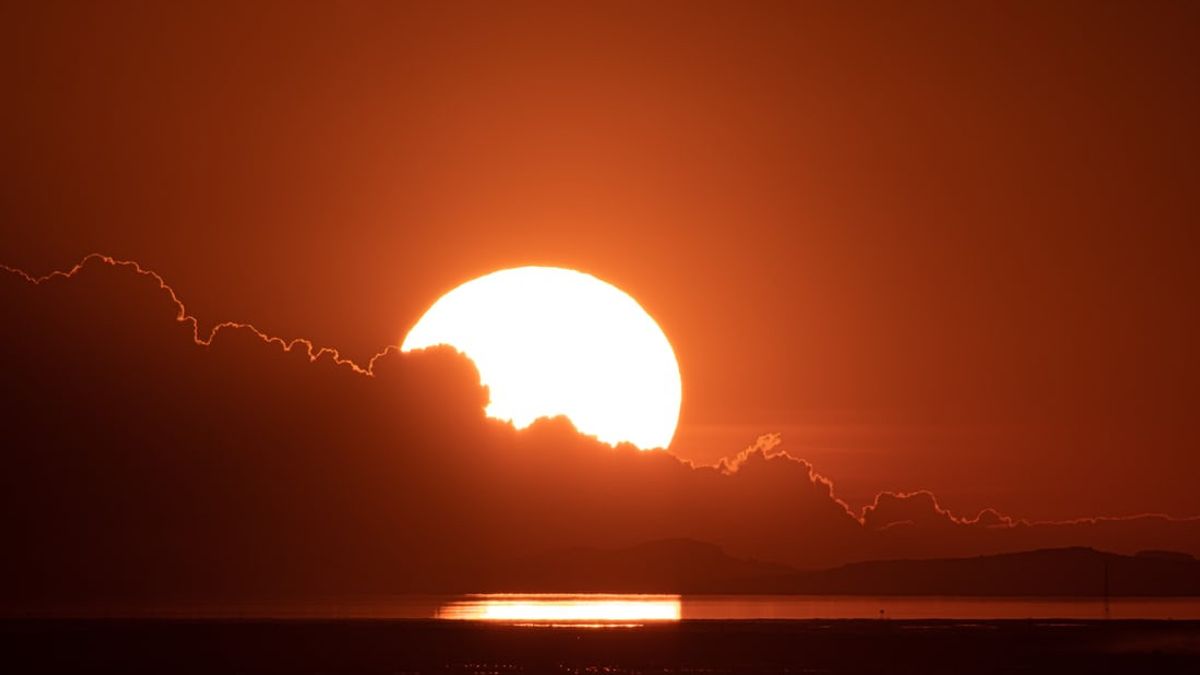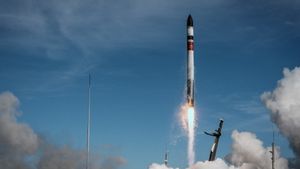
JAKARTA - Last June, astronomy fans were presented with various celestial phenomena, one of which was the most interesting, namely the annular solar eclipse on June 10 last. Now in July, various celestial phenomena can also be witnessed.
Of course, the phenomenon in this month is no less interesting, there is the phenomenon of the Sun above the Kaaba, and there are also comets that pass and meteor showers in two consecutive days. For more details, the following VOI summarizes 11 celestial phenomena that you need to know.
1. Maximum Western Elongation At Mercury - July 5
As explained by researcher from the National Institute of Space and Aviation (LAPAN), Andi Princeg, on July 5, the planet Mercury reaches the farthest western elongation angle.
This phenomenon will reach its peak at 02:43 am local time. This is the best time to see Mercury.
This phenomenon can be seen from the East-Northeast direction near the constellation Taurus or 20 degrees from the eastern horizon. Even though it is visible to the naked eye with a magnitude of 0.3, you will need to use a telescope to see it, because the planet will look like a tiny speck.
2. Moon Apoge Phenomenon - July 6 6
On July 6, there is the phenomenon of the Moon Apoge. The Moon's Apoge is the configuration when the Moon is farthest from Earth. This is due to the Moon's elliptical orbit with the Earth at one of the orbit's focal points.
Meanwhile, the Lunar Perige which will occur at the end of July takes place every 27.32 days on average with the interval of two adjacent Moon Apoges varying between 26.98-27.90 days.
The narrower range compared to perigee is due to the fact that the Moon also orbits the Sun together with the Earth. So, when Perige, will experience a greater perturbation with the Sun than when Apoge.
The Moon Apoge in July 2021 will occur on July 5 at 21:53.19 WIB. So, this Moon's Apoge can only be seen from the East-Northeast near the constellation Taurus at around 02.45 WIB/WITA/WIT, culminates in the North at 08.45 WIB/WITA/WIT and then sets in the West-Northwest at 14.45 WIB/ WITA/WIT.
The moon is 405,308 km from Earth (geocentric) with 17.3 percent illumination (old crescent) at Apoge.
3. Aphelion Earth - July 6
Coinciding with the Moon Apoge on the same day. Aphelion is a phenomenon when the Earth is at its furthest point from the Sun. This is caused by the Earth's orbit which is not a perfect circle but an ellipse with an ellipse of 1 per 60 where the Sun is at one of the two focal points of the ellipse.
So, every year the Earth will be at the closest point to Earth, which falls in early January and the farthest point on Earth, which falls in early July.
This year's Aphelion will occur on July 6, 2021 at 05.27 WITA, 06.27 WITA and 07.27 WIT at a distance of 152,100,527 km. The impact to Earth is not significant because the solar radiation is perfectly distributed to all hemispheres.
Optically, the visible diameter of the Sun will be 1.68 percent smaller than the average of 15.73 arc minutes.
4. Moon-Mercury Conjunction - July 8
The peak of the Moon-Mercury conjunction this month falls at 11.38 WIB, 12.38 WITA and 13.38 WIT with an elongation of 3.7 degrees. Thus, this phenomenon can be witnessed from the East-Northeast direction near the constellation Taurus since 04.30 WIB/WITA/WIT for 60 minutes.
The best time for this phenomenon occurs at 05.00 WIB/WITA/WIT. Mercury's brightness is +0.1 with a wide angle of 7.29" while the Moon's illumination is 3.3 percent (old crescent).
5. New Moon Phase - July 10
This New Moon phase occurs on July 10 at 08.16.33 WIB, 09.16.33 WITA and 10.16.33 with a distance of 404.245 km from Earth (geocentric) and is located in the constellation Taurus.
The sky conditions on July 10 at dusk, Venus and Mars were tilted towards the west and then set in the west at 19:45 and 19:50 WIB/WITA/WIT, respectively. Mercury has been seen since 04.30 WIB/WITA/WIT for 60 minutes from the East-Northeast direction.
Meanwhile, the height of the Moon in Indonesia when the Sun sets varies between +2.36 degrees to +4.26 degrees with the elongation angle to the Sun varying between 4.25 degrees to 5.35 degrees so that the Moon is quite difficult to observe even with tools.
Meanwhile, Saturn can only be seen since 19.20 WIB/WITA/WIT, then Jupiter will follow which has just risen at 20.45 WIB/WITA/WIT and the two giant planets can be seen until 05.30 WIB/WITA/WIT the next day.
6. Moon-Mars-Venus Triple Conjunction - July 11 to 13
This phenomenon occurs for three days from July 11 to 13, 2021. It can be witnessed from 18.40 WIB/WITA/WIT from the West-Northwest for 60 minutes. Mars' brilliance varies from +1.85 to +1.83 while Venus' brilliance tends to stay at -3.89.
The Moon's illumination varies from 2.0 percent to 11.6 percent (light crescent). Initially, Mars and Venus were 1.3 degrees apart on the 11th, while the Moon was 12.56 degrees apart from Venus.
The moon is getting closer to Venus at an angle of 3.16 degrees on the 12th, as is Mars getting closer to Venus at an angle of 0.79 degrees. Finally, the Moon moves away from Mars and Venus at an angle of 11.61 degrees from Venus on the 13th while Mars is in conjunction with Venus and is 0.47 degrees apart.
7. The Sun Over The Kaaba Second Time - July 15
After the Sun was above the Kaaba on 27 May, this month the Sun is again above the Kaaba. This phenomenon is also called Istiwa'ul A'zham (Great Culmination).
This phenomenon occurs when the declination of the Sun is equal to the geographical latitude of the Kaaba, so that at noon, the Sun is directly above the Kaaba.
When that happens, it can be used to check the Qibla direction in Indonesia (except for parts of Maluku Province, starting from Central Maluku Regency, Eastern Seram Regency, Tanimbar Islands Regency, Kei Island Regency), Tual City, Southwest Maluku Regency (minus Wetar Island). ) and Kabupaten Kep. Aru, plus West Papua Province and Papua Province).
The peak of this phenomenon occurred at 16.26.42 WIT, 17.26.42 WITA and 18.26.42 WIT.
8. Mars-Venus-Regulus Triple Conjunction - July 17 to 31
This phenomenon can be witnessed for 15 days from July 17 to July 31 from the West-Northwest since 18.20 WIB/WITA/WIT for 80 minutes.
Regulus's brilliance is +1.35. Meanwhile, the brightness of Mars varies between +1.81 to +1.75. The brightness of Venus varies from -3.90 to -3.92.
At first, Regulus was separated from Venus by 5.71 degrees while Mars was separated from Venus by 2.32 degrees. Four days later (July 21), Regulus is in conjunction with Venus at an angle of 1.35 degrees while Mars is separated from Venus by 4.60 degrees.
Four to five days later (July 24-25), Regulus is between Venus and Mars at an angle of 3 degrees and 3.56 degrees for July 24, and 4.14 degrees and 2.94 degrees for July 25, respectively.
Regulus then comes into conjunction with Mars on July 29 at an angle of 0.73 degrees, while Regulus is separated from Venus by 8.85 degrees. By the end of July, Regulus was moving further away from Venus and Mars.
9. Perige Moon - July 21
This phenomenon is the configuration when the Moon is closest to Earth. This is due to the Moon's elliptical orbit with the Earth at one of the orbit's focal points.
Lunar periges occur on an average of 27 one-third days with intervals of two adjacent lunar periges varying from 245 per 8 to 28 per half day.
Perige of the Moon occurs at 17.34.28 WIB, 18.34.28 WITA and 19.34.28 WIT with a distance of 364,546 km from Earth (geocentric), 90.4 percent illumination (Big Moon/Early Bump) and is in the vicinity of the Ofiukus constellation.
10. Full Moon Phase - July 23 to 24
Also known as the Moon's solar opposition phase, it is a configuration phenomenon when the Moon is facing away from the Sun and in line with the Earth and the Sun.
Given the Moon's orbit which forms an angle of 5.1 degrees to the ecliptic, the Moon does not always enter Earth's shadow during the full Moon phase, so every full Moon phase does not always coincide with a lunar eclipse.
The peak of the full moon phase in June 2021 will occur on June 24 at 09.36.46 WIB, 10.36.46 WITA or 11.36.46 WIT with a distance of 364,546 km from Earth (geocentric) and is located in the constellation Capricornus.
The full moon can be seen for two consecutive days, namely on the night before June 23 before sunset from the East-Southeast.
Then it culminates the next day June 24 before midnight in the South and sets before sunrise in the West-Southwest direction.
In addition, the full moon can be seen on June 24 at night after sunset from the East-Southeast, then culminates the next day June 25 before midnight in the South and sets before sunrise in the West-Southwest direction.
11. Peak of the Delta Aquarid and Capricornid Meteor Showers - July 28 to 29
The peak of this meteor shower occurred on July 28 at 10.00 WIB, 11.00 WITA or 12.00 WIT, so it can be witnessed from July 28 at 19.45 WIB / WITA / WIT from the East-Southeast to July 29 at 05.30 WIB / WITA / WIT from the West- Southwest with a maximum intensity of 14-15 meteors per hour and a speed of 147,600 km per hour.
This meteor shower is thought to be formed from the dust residue of comet 96P/Machholz. The comet is named after the radian point, which is the starting point of the meteor shower located in the star Delta Aquarii (Skat) in the constellation Aquarius.
Delta Aquariid is active from July 12 to August 23 and is best seen before astronomical dawn at around 03.00 – 04.00 WIB/WITA/WIT.
The peak of the Delta Aquarid meteor shower also coincides with the peak of the Capricornid meteor shower, which has been active since July 3 and ends on August 15. The Capricornid meteor shower is formed from the dust remnants of comet 169P/NEAT.
Comet Capricornid speed is slower than Delta Aquarid which is 86,400 km per hour. The maximum intensity of this meteor shower is also smaller, only 5 meteors per hour
This phenomenon can be seen with the naked eye, with clear weather conditions without any obstacles around the field of view. It takes patience to wait for this meteor shower given the relatively little intensity.
In addition, moonlight can interfere with the observations of these two meteor showers because they are still entering the Reducing Moon phase.
The English, Chinese, Japanese, Arabic, and French versions are automatically generated by the AI. So there may still be inaccuracies in translating, please always see Indonesian as our main language. (system supported by DigitalSiber.id)












